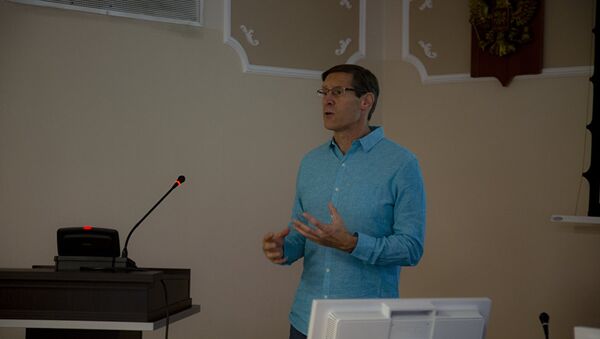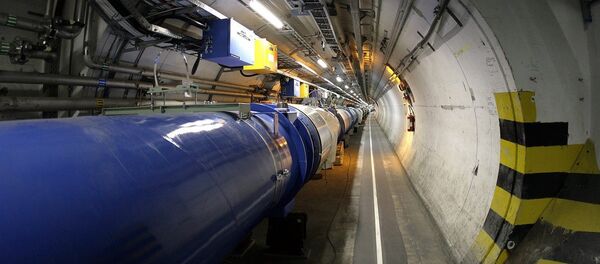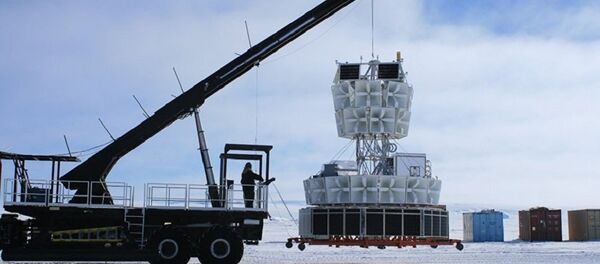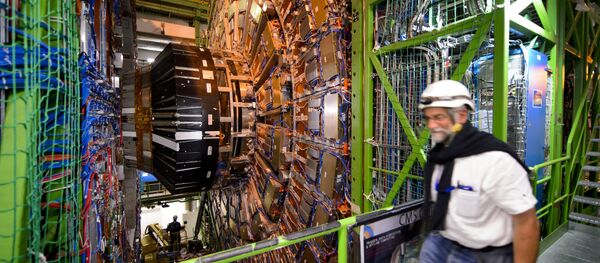The sPHENIX collaboration stipulates experiments on the Relativistic Heavy Ion Collider at Brookhaven National Laboratory (BNL) in Upton, New York. John Lajoie, a physics professor at Iowa State University, discussed the new experiment in an interview with a correspondent of Rossiya Segodnya International Information Agency's Social Navigator project.
Sputnik: Professor Lajoie, what exceptionally fresh opportunities will sPHENIX open for science compared to its predecessor?
If you think about the facility where sPHENIX runs at, RHIC, the Relativistic Heavy Ion Collider, I like to think of that facility as really being similar to a laboratory for strong interaction physics or quantum chromodynamics, which is the name of the interaction between quarks and gluons.
READ MORE: Fuel for Atom Smashers: Siberian Physicists Develop Unique Collider Generator
The other way to look at this is to see what happens if I take the fundamental object of quantum chromodynamics, which is the proton, and I try to understand how the proton is put together. Instead of looking at something big, we look at a small thing but we try to understand in detail how it's put together. So RHIC is the only collider that can do polarized proton-proton collisions in the world. So the ability to look at polarized proton-proton collisions is also very exciting.
Sputnik: Once you said that the understanding of strong nuclear force which connects or binds free quarks inside a proton as well as protons and neutrons inside a nucleus might lead to a revolution during our lifetime, like understanding the electromagnetic force which gave us the opportunity to use it and led to the creation of all modern electronics. We understand that it's merely science fiction but which technologies might appear thanks to the understanding and application of the strong nuclear force?
You can ask somebody in 1865: "Hey, now that you've done this, what is the world going to look like in say a hundred years?" Do you think they would have predicted that we would go to the Moon? Do you think that they would have predicted computing and semiconductors? No, right? They wouldn't have probably been able to even predict a sort of modern electrical power-based society because it hadn't yet been conceived. Yet all of these things came from mastering one of the fundamental forces in nature. But the revolution that came from understanding electrodynamics was one of the most profound revolutions in human history.
READ MORE: Writing on the Wall: 'God Particle' May Destroy the Universe — Scientists
So I don't know what will come of developing an understanding and ultimately mastering the strong force. But the revolution that came from understanding electrodynamics was one of the most profound revolutions in human history. So I'm confident that it will be just as exciting if not more so. So where will we be in terms of nuclear science in 100 years, 150 years or 200 years? I really can't say. But I'm really excited to find out.
Sputnik: Experiments like sPHENIX collaboration require that scientists from all around the world collaborate and of course a huge amount of money in need. For example, CERN created the Internet as we know it. Can we say that it is an investment in the future of mankind?
John Lajoie: So, the Internet was an unanticipated spin-off of the investment in particle physics. Nobody was able to predict that, gee, if I take these really bright people and I give them the resources to attack some of the most complicated problems in understanding the world, this spin-off will come, the internet which is again just another revolution in our society. It's a complete sideline from that effort.
So as academics, we tend to think a lot about our students and our research as well as how our students in postdocs will carry on our research. But they do not necessarily go on to study physics. They go on to do many other things. Ultimately, these same people's contributions have really made a difference in the life of society today.
READ MORE: Russia to Build Fourth Generation Synchrotron on an Island
But training technical people in universities around the world who then go on and use their critical way of thinking and critical problem-solving skills in other fields is one of the drivers of the modern economy in most developed nations.
Sputnik: You know, I heard something like that from one of our older scientists who said that MEPhI is not teaching how to solve something but how to think.
John Lajoie: That's banging on. And that's something I tell all of my incoming freshman students, that they're not there to learn physics. They are there to learn how to think. They're going to learn some physics as a byproduct. But they're there to learn how to solve problems. And many of them don't realize when they're just starting out as undergraduates that they don't have the skills to systematically attack complicated problems. But when they get those skills, those skills apply everywhere and to everything.
Sputnik: So, in order to obtain quark-gluon plasma, scientists need to achieve temperatures that are 80 times higher than the Sun. Which conditions are you planning to achieve in the sPHENIX project?
So we think that RHIC is actually at the sweet spot for studying the kinds of physics that sPHENIX wants to study. And comparing studies at RHIC and studies at the LHC at much higher energies, there is a lot of complementarity between these two. So we really actually need both but RHIC, we really think it is the sweet spot for studying that physics [heavy ion collisions under certain conditions].
READ MORE: Russian Collider: Preparing for the 'Big Bang' in Dubna
The other thing is that we are going to study the same collisions as in PHENIX but we are going to study many more of them. We are not going to increase the temperature but we are going to look at many more collisions than we do at PHENIX. The amount of data, the amount of collisions that we will look at is extremely important.
Sputnik: How are you associated with Russian physicists in general?
John Lajoie: I know many-many Russian physicists through my good friends from the Brookhaven National Lab. So when I joined PHENIX as a young professor back in 1997, I met a lot of really smart and talented people working on PHENIX. So this collaboration, in general, has been very fruitful.
Question: What about MEPhI? Perhaps you want to see MEPhI students in PHENIX working on your data?
One of the things that we'd really like to do in the long term is to provide an opportunity and find a way to bring as many students as possible into sPHENIX and have them participate in the analysis of the data.
The views and opinions expressed by John Lajoie do not necessarily reflect those of Sputnik.









